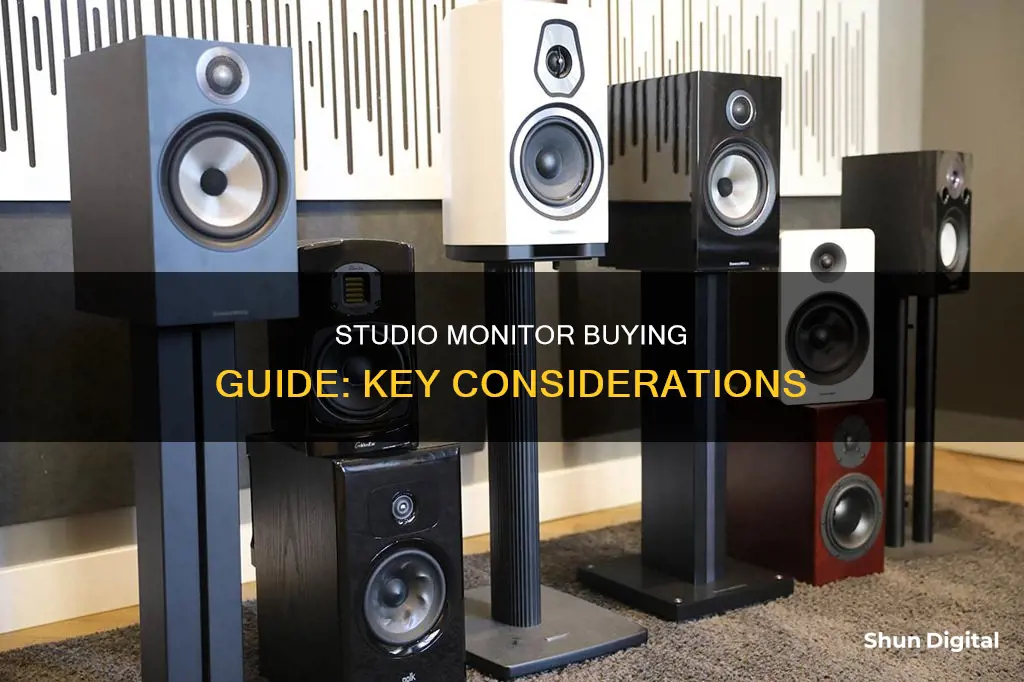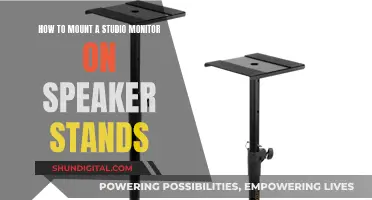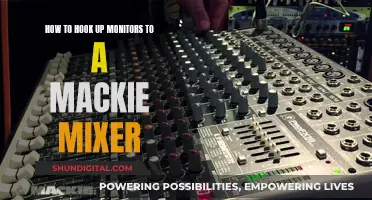
When it comes to studio monitors, there are a few key considerations to keep in mind. Firstly, it's important to understand the difference between studio monitors and regular speakers. Studio monitors are designed to provide an accurate, uncoloured reproduction of the original recording, allowing for precise mixing and mastering. On the other hand, regular speakers are designed to enhance the sound of recordings, often emphasising certain parts of the audio to create a fuller sound.
Another important factor to consider is the type of studio monitor. The two main types are near-field and far-field monitors. Near-field monitors are typically placed closer to the listener, within a distance of around 1 to 2 metres, and are commonly used in home studios to minimise the impact of room acoustics on the mix. Far-field monitors, on the other hand, are larger and more powerful, designed to provide accurate sound across an entire room. They are usually found in high-end professional studios.
Additionally, studio monitors can be either active or passive. Active monitors have built-in amplifiers, while passive monitors require a separate external amplifier. Active monitors are generally more cost-effective and easier to set up, as the amplifiers are already matched to the speakers by the manufacturer.
When choosing studio monitors, it's also crucial to consider the size of the room they will be used in. Smaller rooms, such as home studios, typically require monitors with smaller woofers, usually ranging from 5 to 8 inches. Larger rooms will need more powerful monitors with larger woofers to provide sufficient volume and bass response.
Lastly, the power wattage of the monitors is an important specification to look out for. Higher wattage monitors provide a more detailed sound across a wider dynamic range, reducing the likelihood of distortion. However, this also depends on the type of audio being created, as certain genres such as dance, rock and hip-hop may require more power to handle bass-heavy content.
What You'll Learn

Speaker power and dynamic range
When it comes to studio monitors, speaker power and dynamic range are crucial factors to consider. Here's a detailed guide to help you understand their importance and make an informed decision:
Speaker Power:
The power of a studio monitor, measured in watts, determines its ability to deliver sound without distortion. A higher wattage generally means the monitor can produce louder and clearer sound. For beginners or small-to-medium-sized rooms, 50-75 watts per channel is a good starting point. However, for larger commercial studios, you may need more powerful monitors, such as those with 100 watts or more per channel. It's worth noting that quality is also important; a well-designed, high-quality monitor with lower wattage can sometimes outperform a cheaper one with higher wattage.
Dynamic Range:
Dynamic range refers to the difference between the softest and loudest sounds a speaker can reproduce. In the context of studio monitors, a wider dynamic range means you can hear subtle details in your mix without distortion. This is achieved by having sufficient power delivered to each driver in the monitor. More wattage allows for a greater dynamic range and helps to avoid distortion, resulting in a clearer and more detailed sound.
When choosing studio monitors, it's essential to consider both speaker power and dynamic range. Higher wattage values are generally indicative of a wider dynamic range and lower distortion. By checking the specifications provided by manufacturers, you can make an informed decision about the performance and suitability of the monitors for your specific needs. Remember that the right choice will depend on factors such as room size, music style, and your audio engineering skills.
Best Places to Buy Arcade Monitors
You may want to see also

Amplification
Passive monitors, on the other hand, require external amplifiers, which means they offer more flexibility. With passive monitors, you can choose an external amplifier that best suits your needs and preferences. When choosing an external amplifier for passive monitors, it is important to ensure it matches the power rating and impedance of the monitors for optimal performance.
The power of the amplifier is an important factor to consider. It determines the monitor's ability to deliver adequate sound levels without distortion. For small to medium-sized rooms, a studio monitor with 50-75 watts per channel is usually sufficient. However, for larger commercial studios, an amplifier with higher wattage, such as 100 watts or more per channel, may be required. It is worth noting that a higher wattage does not always mean better quality. A well-designed, high-quality studio monitor with lower wattage can often outperform a cheaper monitor with higher wattage.
When it comes to amplifier configurations, there are three main types: single-amp, bi-amp, and tri-amp. Single-amp is the simplest setup, commonly used for computer speakers, where a single amplifier powers both the left and right speakers. Bi-amp configurations, on the other hand, feature two amplifier modules in each speaker, providing greater control over the frequency response and more precise sound reproduction. This setup is often used in professional studios where accuracy and detail are crucial. Tri-amp configurations are the most advanced and complex, with dedicated amplifiers for each driver in a 3-way speaker system, resulting in the ultimate control over the frequency response and the most precise sound reproduction.
In addition to power and configuration, there are several other factors to consider when choosing an amplifier for studio monitors. Balanced inputs are preferable as they help minimise noise and interference. Reliable speaker terminals, such as 4mm sockets or binding posts, are also important for a secure connection. Convection cooling is another feature to look for, as fan-cooled amplifiers can be noisy and distracting.
When choosing an amplifier for studio monitors, it is essential to consider your specific needs, room size, and the type of music you work with. It is also important to keep in mind that room treatment and acoustics can significantly impact the performance and accuracy of your monitors.
Hillary's Ankle Monitor: Fact or Fiction?
You may want to see also

Room adjustment and EQ
Acoustic Treatment
Acoustic treatment can help to improve the sound quality in your room by reducing reverberation and echo. This can be done through the use of sound-absorbing materials such as acoustic panels, bass traps, and foam. These treatments can help to eliminate unwanted reflections and standing waves, creating a more accurate listening environment.
Speaker Placement
The placement of your studio monitors in the room can greatly affect the sound you hear. It is important to position your monitors correctly to ensure accurate sound reproduction. Place your monitors on stands or pads, facing the short wall in the room. This will help to reduce early reflections and create a clearer sound.
Room EQ-ing
EQ-ing your room can help to flatten the frequency response and improve the overall sound. Use a room EQ software, such as Room EQ Wizard, to measure the room's response and make adjustments. This software will help you identify problem areas and make the necessary changes.
Use a Reference Track
When EQ-ing your room, it is helpful to use a reference track—a track that has been professionally mixed and mastered. By comparing your mixes to a reference, you can identify areas that need improvement and make adjustments accordingly.
Headphones
If you are unable to treat your room acoustically or EQ your speakers, consider using headphones. Headphones can provide a more accurate listening experience, as they eliminate the impact of the room on the sound. However, ensure that your headphones are calibrated correctly to avoid any inaccurate sound reproduction.
By following these steps and making the necessary adjustments, you can significantly improve the sound of your studio monitors and create mixes that translate well outside of your room.
Discovering Your Monitor's Native Resolution: A Quick Guide
You may want to see also

Speaker size
The size of the speaker is an important consideration when choosing studio monitors. The size of the woofer, in particular, will determine the strength of the bass response. Larger woofers will generally provide more powerful bass, but this can be affected by the use of ports.
The size of the speaker will also impact the dynamic range and distortion, with larger speakers typically providing a wider dynamic range and less distortion. This is because larger speakers tend to have more powerful amplifiers, which can deliver higher volumes without distortion.
However, it is important to note that speaker size is not the only factor that determines sound quality. The design and construction of the tweeter and woofer, as well as the ports or radiators, will also influence the sound quality. Additionally, the acoustics of the room can impact the performance of the speakers.
When choosing the size of studio monitors, it is important to consider the size of the room they will be used in. Larger speakers may not be suitable for smaller rooms, as they can overpower the space and cause issues with bass frequencies. For small rooms or home studios, near-field monitors with woofer sizes between 5 and 8 inches are typically recommended.
It is also worth considering the placement of the speakers. If they need to be placed against a wall, front-ported speakers may be preferable to avoid changing the bass response.
While larger speakers generally offer better performance, it is important to consider the budget and space constraints. Smaller speakers with high wattage values can also produce high-quality sound, and may be a more suitable option for those with limited space or budget.
LCD, LED, and TFT Displays: Understanding Differences
You may want to see also

Active vs passive monitors
Active vs. Passive Monitors
While there is a wide range of active studio monitors available today, it's worth noting that the recording industry was built on passive monitors. Both have their pros and cons, so it's important to understand the differences between them.
Passive monitoring systems are modular, requiring you to match your speakers with a separate amplifier and crossover. Active monitors, on the other hand, have these components built-in, offering a convenient plug-and-play solution. This means you don't need to worry about extra gear, and you can be confident that the internal amplifier is specifically matched to the speaker for optimal performance.
Passive Monitors
Passive monitors offer more flexibility as they allow you to choose an external amplifier that perfectly suits your monitors. They are also a good option if you want to upgrade your equipment gradually, as you can upgrade the speaker and amplifier separately. However, passive monitors require more setup and are generally less convenient than active monitors.
Active Monitors
Active monitors are simple to set up and use, making them a reliable choice. They are also often more affordable than passive monitors, as you don't need to purchase additional equipment. Additionally, the built-in amplifiers in active monitors are designed specifically for the monitors, which can result in better overall sound quality.
The decision between active and passive monitors depends on your specific needs and preferences. If you want an easy-to-use, all-in-one solution, active monitors are a great choice. On the other hand, if you're looking for more flexibility and are willing to put in some extra effort, passive monitors might be a better option. Ultimately, both types of monitors can deliver excellent results, and the choice comes down to your personal preferences and requirements.
Finding Your Monitor's Model: A Quick Guide to Success
You may want to see also
Frequently asked questions
Most studio monitors are active, meaning they have built-in amplifiers. Passive monitors require an external amplifier and are less common. Active monitors are generally more cost-effective and easier to set up.
These terms refer to the number of amplifiers and drivers in a monitor. A 2-way or bi-amplified system has a woofer for low frequencies and a tweeter for high frequencies. A 3-way or tri-amplified system adds a third driver to handle mid-range frequencies.
Every monitor will come with a graph of its frequency response. A flatter line means greater accuracy, but no speaker will ever have a completely flat line. Your room will also impact the accuracy of your monitors.
Bass ports are holes in a speaker cabinet that enhance low-frequency resonance. They are strategically placed to extend the low-frequency range of the unit beyond what the woofer can produce.
Subwoofers are not necessary but can be useful, especially for extending the range of smaller monitors. However, hearing too much bass when mixing can be detrimental.







